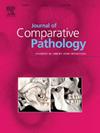Spontaneous soft tissue tumours in aged mouse lemurs (Microcebus spp)
IF 0.8
4区 农林科学
Q4 PATHOLOGY
引用次数: 0
Abstract
Mouse lemurs (Microcebus spp) are small Madagascan strepsirrhine primates increasingly used as an animal model in ageing research. During a period of 10 years, neoplastic disease occurred in 47 grey (Microcebus murinus) and Goodman's (Microcebus lehilahtsara) mouse lemurs from a captive colony in Germany. Approximately half of these tumours appeared histologically as soft tissue tumours (STTs) with a significantly higher proportion of STTs in Goodman's mouse lemurs (87.5%) compared with grey mouse lemurs (38.5%) (P ≤0.025). Most STTs grew subcutaneously in old or senile animals and were commonly located on the trunk, less often on the head and rarely at visceral sites. The majority of STTs were of fibrous or myofibroblastic origin, followed by undifferentiated pleomorphic sarcomas and extraskeletal chondro-osseous neoplasia. Histological grading of malignant STTs revealed all but one as grade II or III, with more than 60% being grade III. Female mouse lemurs of both species were affected significantly more often by grade II and III tumours than males (P = 0.0412). This study gives a comprehensive overview of the spectrum of mesenchymal neoplastic disease in mouse lemurs and highlights some histomorphological characteristics of spontaneous STTs in this small non-human primate species.
老龄鼠狐猴(Microcebus spp)的自发性软组织肿瘤。
鼠狐猴(Microcebus spp)是马达加斯加的一种小型链锁灵长类动物,越来越多地被用作老龄化研究的动物模型。在 10 年的时间里,德国一个人工饲养小鼠狐猴群中的 47 只灰狐猴(Microcebus murinus)和古德曼狐猴(Microcebus lehilahtsara)出现了肿瘤性疾病。这些肿瘤中约有一半在组织学上表现为软组织肿瘤(STTs),其中古德曼鼠狐猴的STTs比例(87.5%)明显高于灰鼠狐猴(38.5%)(P≤0.025)。大多数 STT 生长在年老或衰老动物的皮下,通常位于躯干,较少位于头部,很少位于内脏部位。大多数 STTs 起源于纤维或肌成纤维细胞,其次是未分化的多形性肉瘤和骨骼外软骨骨肿瘤。恶性 STT 的组织学分级显示,除一种外,其余均为 II 级或 III 级,其中 60% 以上为 III 级。两种鼠狐猴中,雌性鼠狐猴患 II 级和 III 级肿瘤的比例明显高于雄性鼠狐猴(P = 0.0412)。这项研究全面概述了小鼠狐猴间质肿瘤疾病的范围,并强调了这种小型非人灵长类动物自发性STT的一些组织形态学特征。
本文章由计算机程序翻译,如有差异,请以英文原文为准。
求助全文
约1分钟内获得全文
求助全文
来源期刊
CiteScore
1.60
自引率
0.00%
发文量
208
审稿时长
50 days
期刊介绍:
The Journal of Comparative Pathology is an International, English language, peer-reviewed journal which publishes full length articles, short papers and review articles of high scientific quality on all aspects of the pathology of the diseases of domesticated and other vertebrate animals.
Articles on human diseases are also included if they present features of special interest when viewed against the general background of vertebrate pathology.

 求助内容:
求助内容: 应助结果提醒方式:
应助结果提醒方式:


